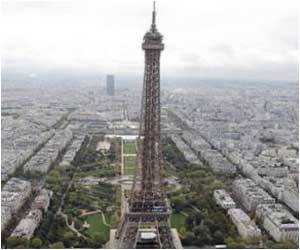Arguably the most widely recognised structure in the world, the Eiffel Tower was designed to stand for only 20 years -- and some predicted it would collapse long before then.

Today, the Eiffel Tower is not only standing but remains in rude health, testifying to the soundness of Gustave Eiffel's design and the strength of "puddle iron," the hand-made wrought iron of the late 19th century, say engineers.
Specialists at the Technical Centre for Mechanical Industries, or CETIM, have put together a high-powered computer model based on the 18,000 pieces that comprise the world's greatest iron edifice and the emblem of Paris.
On screen, the tower has been exposed to hurricane-force winds, lashing rain, extreme heat, cold and thick snow, and each time emerges unbowed, they say.
"We have applied the most demanding test standards currently set in Europe and have found that the tower is in excellent shape," said Stephane Roussin, a former French naval officer in charge of structural safety at Eiffel Tower Operating Co., or SETE.
"We have even doubled its weight to see what happens. The tower moves but is not destroyed."
Advertisement
In 2011, the tower will get its 19th coat of paint, and next year sees an overhaul of structures on its first floor. The tower itself weighs around 8,500 tonnes, to which some 3,000 tonnes (restaurants, lifts, TV antenna and so on) have been added.
Advertisement
But creating the model for the Eiffel Tower presented a technical challenge of a completely new kind.
One thing was that the realisation that its materials -- puddle iron (iron that is super-heated, beaten by hand and then folded over) and rivets -- perform quite differently from modern-day steel, concrete and bolts.
"We had to start from scratch," said Roussin.
Materials scientists carried out mechanical and chemical tests on samples of puddle iron to assess its resilience, and stress engineers revisited Eiffel's own drawings to calculate how the tower would perform under load from the natural elements.
Outwardly simple, the geometry of the tower itself posed some mighty number-crunching problems.
The programme had to take into account a range of weather conditions on a latticework of 18,000 metal pieces and the tower's additions, calculating the load vertically, horizontally and in 3D: in all, the model has an astonishing million variables.
The tower has shrunk by some 13 centimetres (5.5 inches) over the past 120 years because it has settled under its own weight, says Roussin.
Looking to the future, the experiments show the tower's sensitivity to higher temperatures, so global warming is likely to become a bigger source of concern in decades to come.
Even so, the specialists say they are highly confident Paris' "Old Lady" will be around for the next two or three centuries.
Source-AFP







